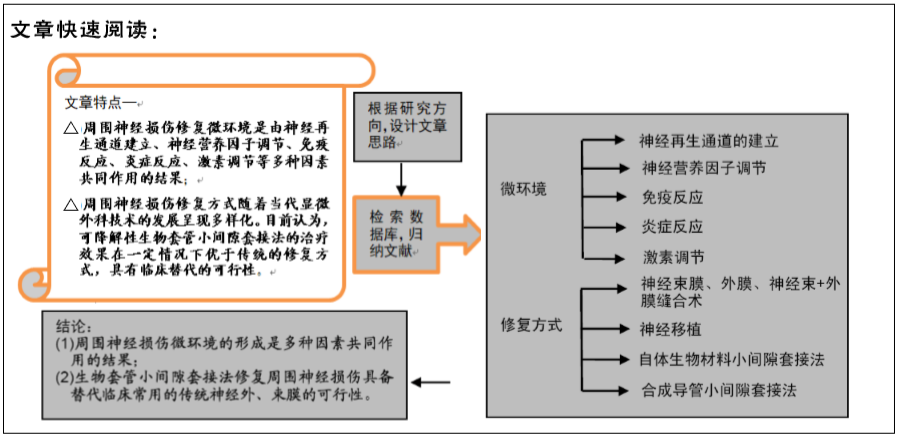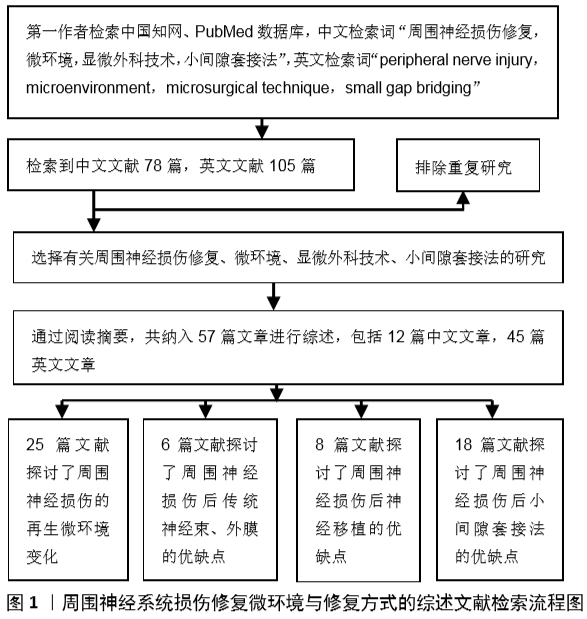[1] CERRI F, SALVATORE L, MEMON D, et al. Peripheral nerve morphogenesis induced by scaffold micropatterning. Biomaterials. 2014;35(13):4035-4045.
[2] MCGEE AW. The Nogo-66 receptor: focusing myelin inhibition of axon regeneration. Trends Neurosci. 2003; 26(4):193-198.
[3] KIM JE,LI S,GRANDPRÉ T,et al.Axon regeneration in young adult mice lacking Nogo-A/B. Neuron. 2003;38:187-199.
[4] GRANDPRÉ T, LI S, STRITTMATTER SM. Nogo-66 receptor antagonist peptide promotes axonal regeneration.Nature. 2002;417(6888): 547-551.
[5] POT C. Nogo-A expressed in Schwann cells impairs axonal regeneration after peripheral nerve injury. J Cell Biol. 2002; 159(1):29-35.
[6] 王冠军,卢世璧,孙明学.周围神经趋化性再生的细胞和分子生物学机制[J].中国康复理论与实践, 2007, 13(3):258-260.
[7] 姚东东,张洁元,刘彬,等.周围神经损伤修复微环境的研究进展[J]. 中国修复重建外科杂志, 2015, 29(9):116-121.
[8] KUBOTA S, NISHIURA Y, HARA Y, et al.Functional and morphological effects of indirect gradual elongation of peripheral nerve: clcctrophysiological and morphological changes at different elongation rate. Hand Surg. 2011;16(2): 105-111.
[9] FARONI A, MOBASSERI SA, KINGHAM PJ, et al. Peripheral nerve regeneration: Experimental strategies and future perspectives. Adv Drug Deliv Rev. 2015;82-83:160-167.
[10] RINKER B, VYAS KS. Clinical applications of autografts, conduits, and allografts in repair of nerve defects in the hand. Clin Plastic Surg. 2014; 41(3):533-550.
[11] SUNDERLAND S. Nerve and nerve injury. New York: Churchill Livingston. 1987:173-176.
[12] LU L, LI W, ZHONG C, et al. Increased apoptosis of immunoreactive host cells and augmented donor leukocyte chimerism, not sustained inhibition of B7 molecule expression are associated with prolonged cardiac allograft survival in mice preconditioned with immature donor dendritic cells plus anti-CD40L mAb. Transplantation.1999; 68(6):747.
[13] KHANNA AK, HOSENPUD JS, PLUMMER MS. Analysis of transforming growth factor-beta and profibrogenic molecules in a rat cardiac allograft model treated with cyclosporine. Transplantation. 2002;73:1543-1549.
[14] SUN JB, LI BL, CZERKINSKY C, et al. Enhanced Immunological Tolerance against Allograft Rejection by Oral Administration of Allogeneic Antigen Linked to Cholera Toxin B Subunit. Clin Immunol. 2000; 97(2):130-139.
[15] ASADA H, SASAJIMA T, INABA M, et al. Venous blood flow through vein grafts before harvesting minimizes endothelial cell desquamation immediately after implantation. J Cardiovasc Surg. 2004;45(2):139-142.
[16] BATTAGLIA M, STABILINI A, DRAGHICI E, et al. Rapamycin and interleukin-10 treatment induces T regulatory type 1 cells that mediate antigen-specific transplantation tolerance. Diabetes 2006;55:40-49.
[17] WALDMANN H, GRACA L, COBBOLD S, et aI.ReguIatory T cells and organ transplantation. Semin Immunol.2004;16: 119-126.
[18] SHI Q, RAFII S, WU MHD, et al. Evidence for circuIating bone manrrow derived endothelial cells,BIood.1998;92(2):362-367.
[19] JARREL BE, WILLIAMS SK, STOKES G, et al.Use of freshly isolated Capillary endothelial cells for the immediate establishment of a monolayerona vascuIar graftat surgery. Surgery. 1986;100(2):392-399.
[20] 徐立静,张澜,呼和,等.周围神经损伤修复方式的研究进展[J].中国实用神经疾病杂志,2016,19(22):118-120.
[21] 任斐,彭婉舒,贡时雨,等.神经再生机制的研究进展[J].中国药物与临床,2014,14(4):473-476.
[22] 韩峰.低浓度血清法培养纯化新生大鼠雪旺细胞[D].大连:大连医科大学,2011.
[23] FENELEY MR, FAWCETT JW, KEYNES RJ. The role of Schwann cells in the regeneration of peripheral nerve axons through muscle basal lamina grafts. Exp Neurol. 1991;114(3): 275-285.
[24] LV W, DENG B, DUAN W, et al. Schwann cell plasticity is regulated by a weakened intrinsic antioxidant defense system in acute peripheral nerve injury. Neuroscience. 2018;382:1-13.
[25] BARTON MJ, JOHN JS, CLARKE M, et al. The Glia Response after Peripheral Nerve Injury: A Comparison between Schwann Cells and Olfactory Ensheathing Cells and Their Uses for Neural Regenerative Therapies. Int J Mol Sci. 2017;18(2): E287.
[26] ENDO T, KADOYA K, KAWAMURA D, et al. Evidence for cell-contact factor involvement in neurite out growth of dorsal root ganglion neurons stimulated by Schwann cells. Exp Physiol .2019;104(10): 1014-1019.
[27] HAO MV. Neruotrophins and their receptors: a convergence point for many signalling pathways. Nat Rev Neurosci. 2003;4(4):299-309.
[28] CHEN ZY, CHAI YF, CAO L, et al. Glial cell line -derived neurotrophic factor enhances axonal regeneration following sciatic nerve transection in adult rats. Brain Res. 2001;902(2): 272-276.
[29] CUI Q, LU Q, SO KF, et al. CNTF, not other trophic factors, promotes axonal regeneration of axotomized retinal ganglion cells in adult hamsters. Invest Ophthalmol Vis Sci. 1999;40(3): 760-766.
[30] FAUSTINO C, RIJO P, REIS CP. Nanotechnological strategies for nerve growth factor delivery: Therapeutic implications in Alzheimer’s disease. Pharmacol Res. 2017; 120:68-87.
[31] 陈国奋,顾立强,裴国献.免疫抑制状态下的神经再生[J].中国创伤骨科杂志,2000,2(2):152-154.
[32] BAVETTA S, HAMLYN PJ, BURNSTOCK G, et al. The Effects of FK506 on Dorsal Column Axons Following Spinal Cord Injury in Adult Rats: Neuroprotection and Local Regeneration. Exp Neurol.1999;158(2):393.
[33] AUSTIN PJ, MOALEM-TAYLOR G. The neuro-immune balance in neuropathic pain: Involvement of inflammatory immune cells, immune-like glial cells and cytokines. J Neuroimmunol.2010;229(1-2):26-50.
[34] 黄恒,沈若武,季爱玉,等.大鼠坐骨神经损伤修复后Thl/Th2细胞因子的表达[J].青岛大学医学院学报,2012,48(2):108-110.
[35] ROTSHENKER S. Wallerian degeneration: The innate-immune response to traumatic nerve injury. J Neuroinflammation. 2011;8(1):109.
[36] NISHIDA T, YANAL R. Advances in treatment for neurotrophic keratopathy. Curr Opin Ophthalmol. 2009;20(4):276-281.
[37] NADEAU S, FILALI M, ZHANG J, et al. Functional recovery after peripheral nerve injury is dependent on the pro -inflammatory cytokinesIL-1beta and TNF:implications for neuropathic pain . J Neurosci. 2011;31(35):12533-12542.
[38] LIEFNER M, SIEBERT H, SACHSE T, et al. The role of TNF -alpha during Wallerian degeneration. J Neuroimmunol. 2000; 108(12):147-152.
[39] UNCINI A, DI MUZIO A, DI GUGLIELMO G, et al. Effect of rhTNFalpha injection into rat sciatic nerve. J Neuroimmunol. 1999;94(1-2):88-94.
[40] KAN J, VELLIQUETTE RA, GRANN K, et al. A novel botanical formula prevents diabetes by improving insulin resistance. BMC Complement Altern Med. 2017;17(1):352.
[41] LI WW, LE GOASCOGNE C, SCHUMACHER M, et al. Type 2 deiodinase in the peripheral nervous system:induction in the sciatic nerve after injury. Neuroscience. 2001;107(3): 507-518.
[42] YU HJ, FEI J, CHEN XS, et al. Progesterone attenuates neurological behavioral deficits of experimental autoimmune encephalolnyelitis through remyelination with nuclessublocalized olig1 protein. Neurosci Lett. 2010; 476(1): 42-45.
[43] MOHAMMADI R, YADEGARAZADI MJ, AMINI K. Peripheral nerve regeneration following transection injury to rat sciatic nerve by local application of adrenocorticotropic hormone. J Craniomaxillofac Surg. 2014;42(6):784-789.
[44] SMITH JW. Microsurgery of peripheral nerve. Plast Reconstr Surg.1964; 33:318-324.
[45] 穆合塔尔,巴吐尔•吾斯曼,盛伟斌.3种缝合方法修复周围神经损伤的临床疗效观察[J].中国伤残医学,2012,20(11):12-14.
[46] 黄若强,张兆毅,邱忠朋.显微外科技术修复周围神经损伤临床观察[J].中国实用神经疾病杂志,2015,18(4):112-113.
[47] MACKINNON SE. Surgical management of peripheral nerve gap. Clin Plast Surg. 1989;16:587-603.
[48] DIESNER SB, RHIEM K, STEWEN K, et al. Peripheral nerve regeneration across 14-mm gaps: a comparison of autograft and entubulation repair methods in the rat. J Reconstr Microsur. 1993;9(05):349-358.
[49] BAIN JR, MACKIRMON SE, HUDSON AR, et al. The peripheral nerve allograft in the primate immunosuppressed with Cyelosporin A: Histologic and electrophysiologic assessment. Plast Reconstr Surg. 1992;90(6):1036-1047.
[50] GRAVVAINS AI, TSOUTSOS DA, TAGARIS GA, et al. Beneficial effect of nerve growth factor-7S on peripheral nerve regeneration through inside-out vein grafts:an experimental study. Microsurgery. 2004;24(5): 408-415.
[51] 卫晓恩,韩西城.多种移植体修复周围神经的比较实验研究[J].中国修复重建外科杂志,1996,10(1):12-15.
[52] RISITANO G, CAVALLARO G, MERRINO T, et al. Clinical results and thoughts on sensory nerve repair by autologous vein graft in emergency hand reconstruction. Chir Main. 2002; 21(3):194-197.
[53] COUTURIER CA, DAUGE MC, HENIN D, et al. Nerve repair using a composite graft of vein and denatured skeletal muscle: morphologic analysis. J Reconstr Microsurg. 2002;18(8): 681-688.
[54] PAN MJ, WANG XH, CHEN YJ, et al. Tissue engineering with peripheral blood-derived mesenchymal stem cells promotes the regeneration of injured peripheral nerves. Exp Neurol. 2017;292:92-101.
[55] DAHLIN LB, ANAGNOSTAKI L, LUNDBORG G. Tissue response to silicone tubes used to repair human median and ulnar nerves. Scand J Plast Reconstr Surg Hand Surg. 2001; 35(1):29-34.
[56] 李剑,姜保国,张殿英,等.生物套管小间隙桥接修复周围神经的实验研究[J].中华手外科杂志,2003,19(2):118-120.
[57] 张培训,李剑,韩娜, 等.剪碎的神经片断和神经生长因子在生物套管小间隙桥接修复周围神经损伤中的作用[J].中国组织工程研究与临床康复,2008,12(23):4465-4468. |


